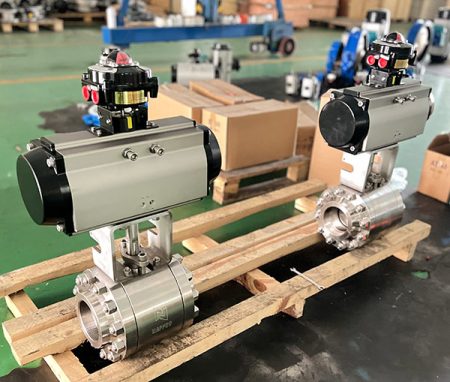
Air actuated valves are very important in industrial automation. They help control movement with great accuracy. These valves are reliable and save money. Air actuators let the valves move quickly and stop in the right place. This is why they are used in pneumatic ball valve and electric ball valve systems. A valve actuator that uses compressed air has many benefits. It works better than old methods, especially where safety and strength are needed. The table below shows how air actuated valves help make automation safer and more productive:
| Feature / Aspect | Contribution to Productivity and Safety in Industrial Automation |
|---|---|
| Non-sparking and no overheating | They work safely in dangerous places and lower fire or explosion risk. |
| Fast response and high force | They make packaging, clamping, and moving materials faster and more accurate. |
| Fail-safe mechanisms | They move valves to safe spots during emergencies to protect people and machines. |
| Energy efficiency and cost-effectiveness | They cut costs and downtime by needing little care and using air well. |
| Durability and simple design | They last in tough places, making them more reliable and safe. |
| Lightweight design | They help robots move faster and use less energy. |
| Customizable solutions | They can be changed for different jobs, helping work go smoothly and follow rules. |
People who work in industrial automation pick air actuated valve technology. They do this to make things run faster and keep safety high in many types of automation.
Benefits of Air Actuated Valves
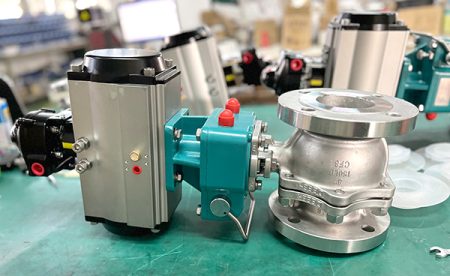
Precision Control
Fast Response
Pneumatic actuator valves react very quickly. This makes them great for jobs that need fast action. Air actuators use compressed air to move valves fast. This helps machines work at high speeds and finish tasks quickly. Fast movement helps companies keep up with their work and reach their goals. Pneumatic valve actuators give quick and accurate control. This is important for jobs that need careful control of pressure, flow, or temperature. They can react right away to signals. This keeps everything running smoothly, even if things change suddenly.
- Pneumatic actuators are fast, safe, reliable, and save energy.
- They work well with new automation systems and can adjust in real time.
- Their simple design makes it easy to use them with other machines.
Accurate Positioning
Pneumatic actuator valves help keep products the same quality every time. These valves can move to the same spot again and again. Some systems are accurate up to 0.1%. Air actuated valves control how much air moves, its pressure, and its direction. This helps machines work the same way each time. When cylinders move together and air flows just right, results stay steady in places like chemical plants, food factories, and oil fields. If you pick the right size and take care of pneumatic actuators, they work well and do not change much. This accuracy lets pneumatic actuator valves work in many different jobs.
Reliability
Low Maintenance
Pneumatic actuator valves are strong and do not need much fixing. Their simple build means there are not many parts to break. This means they do not break down often and need less fixing. This helps work go on without stopping. It is easier to plan when to check and fix pneumatic valve actuators because they last a set amount of time. For example, a pneumatic butterfly valve in a refinery worked for 16,000 hours and only broke four times. That means it lasted 4,000 hours between problems. Fixing them is quick and cheap, which saves money.
Performance in Harsh Environments
Pneumatic actuator valves work well in tough places where other types might fail. They keep working in hot, dirty, or tight spaces. Pneumatic actuators do not get too hot and are not bothered by the weather like electric actuators. They last a long time, even when things are hard. Pneumatic actuator valves can handle gases, liquids, and slurries. They do this without losing power or breaking down. This makes them a good choice for places that need to keep working all the time.
Safety
Intrinsically Safe
Air actuated valves are made to be safe. Pneumatic actuator valves do not make sparks or get too hot. This makes them safe to use where fires or explosions could happen. They do not have electric risks and help stop fires in dangerous places. Many pneumatic valve actuators meet strict safety rules, like ATEX and IECEx. These rules mean the valves are built to stop explosions and fires. These safety marks show pneumatic actuators follow world safety rules and keep people and machines safe.
| Standard | Focus Area | Region | Key Requirement |
|---|---|---|---|
| ATEX | Explosion safety | Europe | Explosion-proof design, ignition prevention |
| IECEx | Explosion safety | Global | Strict testing and design criteria |
| API 6D | Pipeline valves | Worldwide | Fire safety, pressure containment, leak prevention |
Fail-Safe Operation
Pneumatic actuator valves have a special safety feature. If the power goes out or something fails, these valves move to a safe spot. They can open or close by themselves. This keeps people and machines safe from harm or accidents. Air actuated valves that work by themselves lower the chance of mistakes. They make sure things run the same way every time. You can control them from far away and watch them in real time. This makes things even safer in factories. Fast action and good control help stop accidents and keep workers safe.
Tip: Automated pneumatic actuator valves can find leaks, send warnings, and shut down from far away. This helps stop accidents from getting worse.
Cost-Effectiveness
Affordable Operation
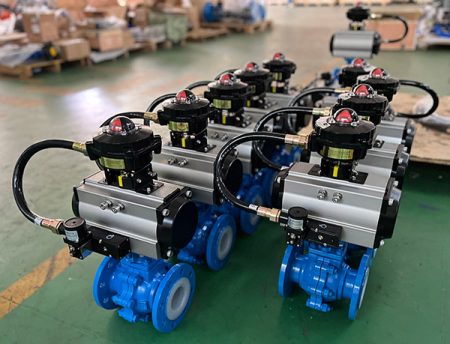
Air actuated valves help factories save money and work well. They use compressed air, which most factories already have. The price to buy pneumatic actuators is not the highest or lowest. Electric actuators cost the most to buy at first. Pneumatic systems need a bit more to set up because they use air. Hydraulic actuators are cheaper to buy but cost more to install. This is because they need a special hydraulic power unit.
| Cost Aspect | Pneumatic Actuators | Electric Actuators | Hydraulic Actuators |
|---|---|---|---|
| Initial Purchase Price | Moderate; between hydraulic and electric | Highest initial purchase price | Lower than electric |
| Installation Costs | Moderate; requires compressed air source | Relatively low; only electrical connection | Higher; needs hydraulic power unit |
| Operation Costs | Higher due to energy inefficiency in air compression | Lower due to high energy efficiency | Higher due to inefficiencies and fluid use |
| Maintenance & Repair | Frequent due to potential air leaks | Generally low; fewer moving parts, no fluids | Frequent due to leaks and seal wear |
| Lifespan | Durable and long | Long lifespan | Long lifespan |
| Replacement Costs | Low to moderate | Lower due to long lifespan | Moderate |
| Environmental Costs | Lower than hydraulic; no oil leaks but energy inefficiency impact | Minimal; no fluid leaks, energy efficient | Significant risk of oil leaks and cleanup costs |
Pneumatic valves are both strong and not too expensive. They do not need costly fluids or tricky wiring. Their simple build means there are fewer things to break. This keeps repair and replacement costs down. Many factories pick air actuated valves because they work well and do not cost as much as electric ones. They also do not make a mess like hydraulic fluids. This makes them a smart choice for saving money in automation.
Reduced Downtime
When machines stop, factories lose time and money. Air actuated valves help stop this from happening. Their simple design makes them easy to use and fix. Workers can watch and control these valves from far away. This means fewer mistakes and less checking by hand. The valves react fast to changes in flow or pressure. This keeps everything working smoothly.
Pneumatic valves help with planning repairs before things break. By counting how many times a valve moves, workers know when to fix it. This stops surprise problems and keeps machines running longer. Factories with air actuated valves stop less often. This means they lose less time and make more products.
Note: Watching pneumatic valves in real time helps teams find problems early and plan repairs. This cuts down on machine stops even more.
Pneumatic Valve Actuators vs. Other Types
Electric Actuators
Electric actuators use motors to move valves. They can control how far, how fast, and how hard a valve moves. This is good for jobs that need tiny changes. Electric actuators are slower than pneumatic actuator valves. Most electric actuators take about six seconds or more to finish one cycle. Pneumatic actuator valves can finish a cycle in less than one second. Electric actuators are bigger and do not last as long. They usually work for about 250,000 cycles. Pneumatic actuator valves are smaller and can last up to one million cycles. Electric actuators do not need much fixing. Most parts are greased forever, and only the rod seal needs changing sometimes. But they must stay in the right temperature range or they can break. Electric actuators work best in clean places where being exact is more important than being fast.
Hydraulic Actuators
Hydraulic actuators use fluid under pressure to move valves. They give a lot of force, so they are good for heavy jobs. Hydraulic actuators work at higher pressures than pneumatic actuator valves. This lets them move big valves or handle strong systems. But hydraulic actuators need more care. Workers have to change oil, swap filters, and look for leaks. Hydraulic systems can be messy and harder to take care of than pneumatic actuator valves. Pneumatic actuators do not leak fluids like hydraulics. Hydraulic actuators are also bigger and heavier. They are best for places like building sites or big factories where lots of force is needed.
When to Choose Pneumatic
Pneumatic actuator valves are great for many factories. They move fast and give strong force for their size. Pneumatic actuators can finish a cycle in half a second. This makes them good for quick jobs. Many factories already use compressed air, so adding pneumatic actuator valves is simple. Pneumatic actuators work well in tough or dangerous places. They do not make sparks or get too hot, which keeps people safe. Pneumatic actuator valves have easy safety features, like springs that move valves to a safe spot if power goes out.
Pneumatic actuator valves need some care. Workers must keep seals tight to stop air leaks. This is easier than taking care of hydraulic systems but a bit more work than electric actuators. Pneumatic actuator valves are great for clean places like food, drink, and medicine factories. They do not leak fluids, so they keep things clean. Pneumatic actuators also work well in conveyor belts, packaging, and assembly lines. They give strong force and speed, even in very hot or cold places from -40°F to +250°F.
Tip: Pick pneumatic actuator valves when you need speed, some force, and safety.
| Actuator Type | Speed (Cycle Time) | Force/Torque | Maintenance Level | Best Use Case |
|---|---|---|---|---|
| Pneumatic | 0.5–1 second | High for size | Moderate | Fast, repetitive tasks, hazardous or clean environments |
| Electric | ~6 seconds or more | Moderate | Low | Precision control, clean environments |
| Hydraulic | N/A | Very High | High | Heavy-duty, high-force applications |
Pneumatic actuator valves give a good mix of speed, strength, and safety. They are best for places that need quick, safe, and clean work.
Electric Valves: Features and Applications
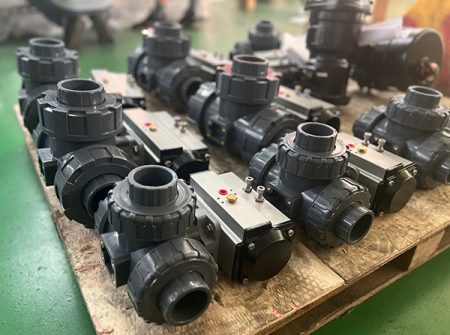
Electric valves are important in today’s factories. They use electric motors and gearboxes to move parts of the valve very accurately. People can control them with simple on/off signals or more detailed signals for exact movement. Electric valves have many helpful features:
- They can move in straight lines or turn, and stop exactly where needed.
- They work with control systems and give feedback right away.
- They use less energy and make little noise.
- They have safety parts like torque and stroke limiters.
- You can use a handwheel if there is an emergency.
Electric valve actuators change electrical power into movement. They use AC or DC motors with gearboxes to make more force and slow down the speed. Some have limit switches and overtorque protection to stop damage and keep things safe.
Electric valves are used in many places. People use them in water plants, factories, and heating or cooling systems. They are also found in chemical plants and other jobs that need valves to move just right. Smart linear electric actuators give feedback and can be programmed, so they are good for process industries. Rotary electric actuators turn quarter-turn valves in water treatment and oil and gas. Linear electric actuators are used in metal work, power plants, and making chemicals.
Electric valves need steady power to work well. They do not work well if the power goes out a lot or if there is a lot of shaking. But they do not need much fixing, are easy to put in, and save energy. They are quiet and have good safety features, so many people use them in automated systems.
Note: Electric valves help control processes, lower downtime, and make factories work better.
What Are Pneumatic Valves?
Pneumatic valves are a big part of many automated systems. These valves control how air moves, its direction, and its pressure in pneumatic circuits. Pneumatic actuator valves use these valves to send air to cylinders and other actuators, so things move fast and right.
Pneumatic valves work in different ways. Some use moving spools, others use springs or ball and gate shut-offs. People can move these valves by hand, with electricity, or with air pressure. Pneumatic actuator valves need these control valves to manage airflow and keep things working well.
A normal pneumatic valve system has directional control valves, flow control valves, and pressure relief valves. Directional control valves decide which way the air goes, so actuator valves can move machine parts fast. Flow control valves change how fast actuators move, so everything runs smoothly. Pressure relief valves let out extra air to keep the system safe.
| Valve Type | Core Functionality and Operation Mechanism | Typical Pressure Range | Temperature Range | Material and Durability Notes |
|---|---|---|---|---|
| Directional Control Valve | Changes air direction with a moving spool. Air pressure or actuators move the spool. Common types have 2/2, 3/2, or 5/2 ports. | 0 to 10 bar | -10°C to 80°C | Made from strong materials like aluminum or brass for tough jobs. |
| Flow Control Valve | Controls how fast air moves by changing the opening size. | 0 to 10 bar | -10°C to 80°C | Made from aluminum or stainless steel, good for many fluids and temperatures. |
| Pressure Relief Valve | Uses a spring to open at a set pressure (5 to 8 bar) and let out extra air. | 5 to 8 bar | -10°C to 80°C | Made from stainless steel, built for harsh places and long use. |
| Pneumatic Shut-off Valve | Uses a ball or gate to stop air flow for on/off control. | 0 to 10 bar | -10°C to 80°C | Made from brass or strong plastic, stands up to wear and rust. |
Pneumatic actuator valves and actuators need these valves to work fast and well. Their small size and safety parts make them important in factories. Pneumatic actuator valves help things run safely and save energy by stopping too much pressure.
Hydraulic Control Valves: Features and Applications
Hydraulic control valves give strong movement for big industrial jobs. These valves control how hydraulic fluid moves to start, stop, or change how actuators move. People use hydraulic control valves in systems that need a lot of force and tough parts.
Hydraulic actuators make big forces, so they are good for hard jobs. Automated hydraulic valves help things run better by giving exact control and cutting down on mistakes. These systems let you watch things in real time and fix problems before they get worse. Hydraulic control valves also make things safer by letting you control them from far away and shut them off fast in emergencies.
Hydraulic control valves have these main features:
- They control which way the fluid goes.
- They can stop, let through, or change the fluid’s path.
- There are two-way, three-way, four-way, check valves, and solenoid valves.
- Solenoid valves use electronics for quick and exact control.
- Cartridge valves save space and handle lots of fluid.
People use hydraulic control valves in building, mining, and heavy factories. These valves can handle high pressure and big loads. But hydraulic systems need regular care and can be affected by temperature changes. They also cost more to buy than other types.
Tip: Automated hydraulic valves help cut downtime, save energy, and make tough jobs safer in big factories.
Applications in Industrial Automation
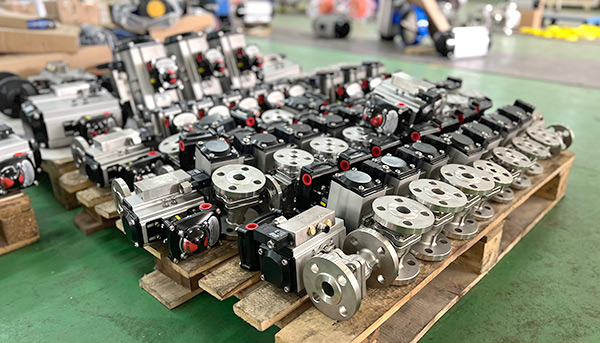
Process Industries
Process industries use pneumatic actuators to control valves and keep things safe. In chemical and drug factories, these actuators help run control valves by themselves. This makes the work safer and helps follow rules about the environment. Pneumatic actuator valves control how things flow, protect machines, and can shut off in emergencies. They meet tough rules for temperature, pressure, and stopping leaks, which is important in these jobs.
Pneumatic actuators are used in many ways to control fluids. For example, chemical plants use them in vacuum distillation to separate things that can’t take much heat. In making candles for medicine, they help control vacuum on wax tanks so smells do not escape. Science labs use pneumatic actuators to safely remove gases when mixing liquids, even with high heat or strong chemicals. Making computer chips also needs these actuators to keep the right vacuum in special rooms.
Part-turn pneumatic actuators work in oil refineries and water plants. They control valves for cleaning oil and separating it. These actuators are tough and very exact, so they are good for hard jobs in factories. They help machines work by themselves, make things run better, and keep people safe when working with dangerous chemicals.
Water and Wastewater
Water and wastewater plants use pneumatic actuators to open and close valves. This makes the work faster and safer. These actuators take the place of people turning valves by hand. Now, workers can control and watch valves from far away. This means fewer people need to go into dangerous or hard-to-reach spots. Pneumatic actuators give steady control over jobs like filtering, adding chemicals, blowing air, and handling sludge.
| Aspect | How Pneumatic Valves Improve Efficiency and Safety in Water and Wastewater Treatment Plants |
|---|---|
| Flow Regulation | Control flow and pressure to help with jobs like blowing air, settling, adding chemicals, filtering, and cleaning water. |
| Automation | Let people run and check valves from far away, so they do not have to go into risky places. |
| Regulatory Compliance | Make sure cleaned water meets rules, so there is less pollution and the plant follows the law. |
| Operational Cost Savings | Save energy by keeping flow and pressure steady, which lowers costs. |
| Process Reliability | Give steady control over hard jobs, so the plant works better. |
Pneumatic actuators also stop air bubbles, airlocks, and water hammer, which can break pipes. New air valves can let air out, let air in, and stop surges to keep pipes safe. Better designs, like no gaskets and strong materials, make them last longer and easier to fix. These things help water and wastewater systems work safely and well, so pneumatic actuators are very important in these jobs.
Oil and Gas
The oil and gas industry uses pneumatic actuators to run valves in dangerous places. These actuators use air to move valves, so there are no sparks and it costs less. Pneumatic actuator valves turn hand valves into automatic safety parts, which are needed for emergency shutoffs. This keeps people away from danger and makes sure the system reacts fast if something goes wrong.
Pneumatic actuators are picked in oil and gas jobs because they do not cause sparks. They work fast, which is important for emergency valves that must close quickly. Workers use them with ball and butterfly valves to control flow and shut down in emergencies. These actuators can be hooked up to control systems like SCADA and DCS for remote control and checking. This means fewer people have to go into risky places like oil rigs and refineries, making things safer and smoother.
Pneumatic actuators help companies follow rules like API, ATEX, and IECEx. They are trusted, save money, and work well in dangerous spots, so they are a top pick for running valves in oil and gas. Their energy savings and good performance help keep work safe and running all the time in tough places.
Powder Handling and Processing
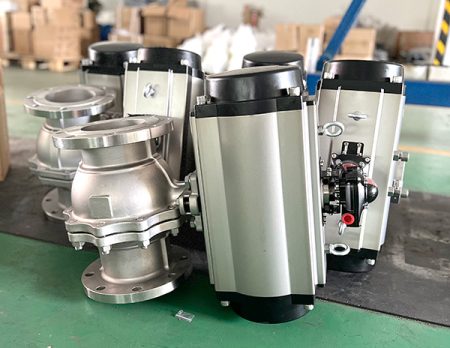
Air actuated valves are very important for moving powders. Many factories need to control powders and granules exactly. Rotary airlock valves have star-shaped rotors that measure powders in pneumatic systems. These valves keep the air inside, which keeps pressure different. This stops leaks and keeps things clean and safe.
Factories use air actuated valves to move powders with high or low pressure. The valves stop dust from getting out, which keeps workers and machines safe. Keeping dust in is very important in drug, food, and chemical factories. These valves are made with hard steel and special rotors. This stops powder from blocking the valve or wearing it out. It helps powders flow well and means less fixing is needed.
Air actuated valves help move big amounts of powder by machine. They let powders move between machines without stopping or leaking. This makes work faster and keeps people safe. Companies use these valves to follow safety and quality rules. With air actuated valves, factories can move powders with less waste and danger.
HVAC and Ventilation Systems
Air actuated valves make HVAC and ventilation better in factories. These valves control air and temperature to keep places comfy and save energy. They listen to sensors, so the system changes by itself.
- Air actuated valves help save energy by running only when needed.
- They lower costs and help the planet by using less power.
- The valves help machines last longer by stopping extra use.
- They work with smart building systems for better control.
- By moving dampers and valves, they keep air clean inside.
Valve actuators move hot or cold air to keep rooms just right. They let people control things from far away, which is good for new factories. The valves react fast to signals, so energy is not wasted. Some have safety spots if something goes wrong. They also work with lights and security for full building control.
Food and Beverage Filling Machinery
Air actuated valves help food and drink machines work fast and stay clean. Many factories need valves that move quickly and always work right. Pneumatic actuators turn butterfly, ball, and plug valves fast. They are made from materials that do not rust, so they stay clean and strong.
- Fast valves help fill bottles and cans quickly.
- Smooth parts and special materials keep things clean.
- Easy-to-fix designs mean less time stopped for repairs.
- Valves that drain themselves stop germs from growing.
- Some valves keep pressure steady, which keeps food good.
Factories use air actuated valves to keep filling lines working well. The valves move fast and change pressure without needing computers. This keeps food and drinks good and makes work quick. Food-safe and rust-proof parts let workers clean them often. Valve groups made with safe materials are easy to clean and fix. These things help factories fill food and drinks fast, safe, and clean.
Steam Systems
Steam systems are important in many factories, like power plants, food factories, and chemical plants. These systems need careful control of pressure and flow to work safely and well. Air actuated valves, called pneumatic actuators, have many good points for these tough jobs.
Pneumatic actuators use air under pressure to move valves. This lets them open or close valves fast, even when steam pipes have high pressure. People pick air actuated valves because they react quickly when flow changes. Fast action keeps pressure and flow steady, which is needed for safety and good products.
Factories often link pneumatic actuators to control systems, like PLCs and valve positioners. This setup lets workers control steam valves from far away. They can change valve spots from a control room, so they do not have to go into risky places. Automated control also lets the system make small changes, so steam flow and pressure stay just right.
Air actuated valves are small and light. This makes them good for places with little space or where weight matters. They are built to work well in hard places. Air filter regulators keep dirt out and make sure the air is at the right pressure. This helps the actuators last longer and need less fixing.
Key benefits of air actuated valves in steam systems include:
- They react fast to signals, so changes happen right away.
- They move valves to the right spot for good steam control.
- They have enough force for tough steam pipes.
- They save money, especially when many valves share air.
- They are safer because they do not make sparks or get too hot.
Note: Pneumatic actuators help stop dangerous pressure jumps and let systems shut down safely if there is an emergency.
Many factories use air actuated valves to keep steam systems working well. These valves help save energy by stopping steam from being wasted and keeping control tight. They work with new automation systems, so people like to use them in both old and new steam setups. By picking air actuated valves, workers get safe, reliable, and low-cost steam control in many different jobs.
Integration with Automation Systems

Modern factories need pneumatic valves to work with automation systems. This helps workers control machines from one place and watch them live. Pneumatic valves fit well with PLCs, remote tools, and smart automation systems. They are simple and easy to add, so many factories use them.
PLC Compatibility
Pneumatic valves link to PLCs with parts like solenoid valves, limit switches, and positioners. These parts help the actuator get signals and tell where the valve is. The PLC can change the valve to keep things working right. Pneumatic systems use converters or positioners to turn electric signals into air pressure. This lets the valve move just right and gives better control.
4-20mA Signal Integration
Many pneumatic valves use 4-20mA signals to control them. This signal is good for factories because it does not get mixed up by other electric signals and works far away. The PLC sends a current to the valve, which moves it to the right spot. The valve can also tell the PLC where it is. This system helps things work better and more exactly. Some smart positioners can check themselves and warn when fixing is needed, so machines do not stop by surprise.
0-10V Signal Control
Some systems use 0-10V signals to control pneumatic valves. The PLC sends a voltage to the valve, and the valve moves based on how strong the voltage is. This way is easy and works best for short wires. Both 4-20mA and 0-10V signals help PLCs and other machines work together smoothly.
Remote Control
Workers can control pneumatic valves from far away using digital systems like HART, Profibus, or wireless tools. These let workers see what the valve is doing, change settings, and get warnings without being close. Live feedback helps teams find problems early and fix them before things break. This makes work safer and keeps machines running.
Tip: Watching and controlling valves from far away means workers do not have to go into dangerous places, so it is safer.
Scalability
Pneumatic valves are easy to add to as factories grow. Their design lets companies put in more valves or change them without starting over. Standard parts make it simple to upgrade or expand when more work is needed. This helps businesses grow and saves money. Pneumatic systems work for small and big jobs, so they are a good pick for many factories.
Maintenance and Reliability
Simple Maintenance
Pneumatic actuators are easy to take care of. They have fewer moving parts than electric or hydraulic actuators. This makes them less likely to break. Many factories use pneumatic actuators because they do not need repairs often. Workers can check and fix these valves quickly. This means machines do not stop for long and work keeps going.
- Pneumatic actuators last a long time and work well.
- They do not need much fixing and save money.
- Their simple build means they break less often.
- Pneumatic actuators work without electricity, so there are fewer electrical problems.
- They do not get too hot or have trouble with water, so they need less care.
Workers mostly check the air supply and seals. If the air is clean and dry, pneumatic actuators work the same every time. Maintenance teams can plan when to check them, so there are no surprise stops. This helps keep machines running in tough places.
Long Service Life
Pneumatic actuators are strong and last for years. They can do the same job over and over without breaking. They last longer than electric and hydraulic actuators before needing to be changed. The table below shows how long each type usually lasts:
| Actuator Type | Typical Service Life (Cycles) |
|---|---|
| Pneumatic (Rack & Pinion) | Approximately 1,000,000 cycles (within specifications) |
| Electric | Approximately 250,000 cycles (application dependent) |
| Hydraulic | Not specified by cycles; known for robustness |
Pneumatic actuators are tough and keep working for a long time. They can handle wet air and big changes in temperature. This is why many factories pick them. Factories do not have to replace them often or fix them a lot. This saves money over time. Pneumatic actuators keep working well, so important jobs do not stop.
Troubleshooting
It is easy to find and fix problems with pneumatic actuators. Most problems come from the air supply, like leaks or low pressure. Maintenance teams look at hoses, seals, and regulators to find what is wrong. Because there are not many parts, it is faster to find and fix problems than with electric or hydraulic systems.
- Pneumatic actuators are strong and do not have many problems like getting too hot.
- Their small size and simple build make them easy to reach and fix.
- They move fast and work well, so teams can spot problems quickly.
Checking how many times they move and the air quality helps stop failures. When teams follow a set plan for checking them, pneumatic actuators stay reliable and work the same every time. This means fewer surprise stops and safer, better work.
Tip: Clean and dry air helps pneumatic actuators last longer and work well.
Safety and Compliance
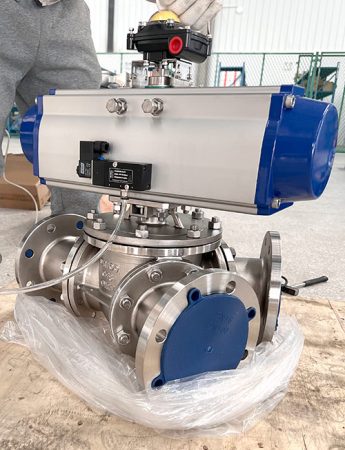
Hazardous Environments
Air actuated valves help keep factories safe, especially in dangerous places. These valves do not make sparks or get hot. This lowers the chance of fire or explosion. Many factories use them where there are flammable gases, dust, or chemicals. Pneumatic actuators use compressed air, not electricity, so they are safer. This is why oil refineries and chemical plants use them. Workers trust these valves to protect people and equipment.
ATEX Certification and Compliance
ATEX certification shows a product is safe in explosive places. The European Union made ATEX rules to keep workers and property safe. Air actuated valves with ATEX certification follow strict design and testing rules. These valves stop sparks and control static electricity. Factories in Europe and other places use ATEX-certified valves to follow the law and prevent accidents. Meeting ATEX and IECEx standards means air actuated valves are safe in risky areas. Companies that use certified valves show they care about safety and following the law.
Note: ATEX-certified air actuated valves help companies avoid fines and shutdowns by following safety laws.
Industry Standards
Air actuated valves must follow many industry rules. These rules cover safety, how well they work, and their effect on the environment. Groups like API, ISO, and IEC make these rules. Valves that meet these rules work better and last longer. They also help companies pass checks and audits. Many jobs need valves to have certifications before using them. This makes sure every valve is safe and works well.
- API 6D: Focuses on pipeline safety and stopping leaks.
- IECEx: Sets world rules for equipment in explosive places.
- ISO 9001: Makes sure factories manage quality well.
Following these rules helps companies earn trust from customers and inspectors.
Environmental Impact
Air actuated valves help factories stay clean and protect nature. These valves use compressed air to move fluids, so they do not need oil or other fluids that can leak and pollute. Automated valves only work when needed, saving energy and cutting waste. They also help factories control pollution and use resources wisely.
| Industry/Application | Contribution to Environmental Sustainability and Clean Operation |
|---|---|
| General Industrial Systems | Automated valves save energy by working only when needed. They control fluid flow exactly, which lowers pollution and makes work more efficient. |
| Blue Ammonia Production | Help control gases and chemicals, support carbon capture, and manage pressure. This lowers emissions in oil and gas refining. |
| Desalination Plants | Control water and brine flow, manage waste, and save energy. This helps protect the environment and lowers pollution. |
| Power Plants | Control fuel, steam, and water to work better and lower bad emissions like CO2 and NOx. They also manage steam, fuel, and ash. |
| Chemical Industries | Make work safer by lowering exposure to dangerous chemicals and pollution with careful control. |
Pneumatic actuated valves help factories reach environmental goals. They save energy by giving exact control and automation. As technology gets better, these valves become even more efficient and green. Many factories pick air actuated valves to lower pollution and keep work clean.
Tip: Picking air actuated valves helps companies meet safety and environmental rules and work better.
Trends in Automation
Smart Valves
Smart pneumatic actuators are changing how factories work. These devices have sensors that watch pressure, flow, temperature, and valve position all the time. Operators can see how each actuator is working and find problems early. This helps teams fix things before they break. It is called predictive maintenance. Smart pneumatic actuators use data to change air flow and pressure. This makes the system work better.
Many companies use open-source Industrial Ethernet and IO-Link. These help pneumatic actuators join modern automation networks. Factories can add new smart actuators without changing everything. This makes it easy to use old and new machines together. The market for smart pneumatic actuators is growing quickly. They are used a lot in car making, oil and gas, and food factories.
Tip: Smart pneumatic actuators help factories save money by stopping downtime and making work faster.
IIoT Integration
The Industrial Internet of Things (IIoT) links pneumatic actuators to control systems with wireless networks. This lets operators watch and control valves from anywhere. IIoT actuators send data about position, pressure, and vibration to main computers. Artificial intelligence uses this data to make changes right away. This creates valve systems that fix themselves and work better.
Wireless standards like WirelessHART, ISA100, and 5G make it easy to set up and upgrade actuators. Factories can use battery-powered controllers and do not need long wires. The table below shows important trends in IIoT and pneumatic actuator technology:
| Trend/Aspect | Description |
|---|---|
| IIoT and AI Integration | Wireless networks connect valves to control systems; AI helps valves fix themselves and work better. |
| Advanced Condition Monitoring | Online checks help fix problems early, so there is less downtime and lower costs. |
| Wireless Communication Adoption | Wireless standards make setup cheaper and let factories add new parts easily. |
| Market Impact | Better reliability, safety, uptime, and efficiency in many industries. |
Pneumatic actuators with IIoT features help factories work safer and faster. These new tools help many jobs, like making cars, cleaning water, and making computer chips.
Sustainability
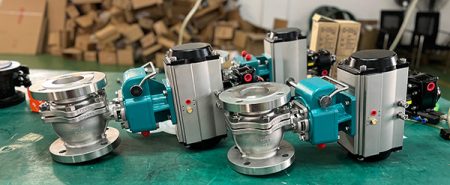
Sustainability is very important in today’s factories. Pneumatic actuators now use data to control air and save energy. This cuts down on waste and helps factories use less power. Factories can see how much energy each actuator uses and change settings to save more. These changes lower costs and help companies protect the environment.
Smart pneumatic actuators also help stop leaks and keep pollution down. Automated checks make sure valves only use air when needed. This saves energy and keeps the factory cleaner. As more factories use automation, pneumatic actuators help make work greener and more efficient.
Note: Picking pneumatic actuators with smart features helps companies save energy and protect nature.
Air actuated valves are very important in factory automation. They help control machines exactly and keep things safe. These valves are trusted because they work well and last a long time. Many factories use them to save money and work faster.
- Experts can look at air actuated valves for new or better systems.
- It is easy to add these valves to new automation setups.
Tip: Think about what your factory needs now and talk to valve experts to pick the best valves for your machines.
FAQ
What is an air actuated valve?
An air actuated valve uses compressed air to open or close. The actuator gets a signal and then moves the valve. These valves work in many jobs because they act fast and are safe.
How do air actuated valves improve safety?
Air actuated valves do not make sparks or get too hot. They work well in dangerous places. Many have special safety features. These features move the valve to a safe spot if there is an emergency.
Where are air actuated valves commonly used?
Engineers use air actuated valves in chemical plants, water treatment, oil and gas, food factories, and HVAC systems. These valves control fluids, gases, or powders in machines that work by themselves.
What maintenance do air actuated valves require?
Technicians check the air supply, seals, and connections. They change old parts when needed. Clean, dry air helps the valves last longer. Regular checks stop leaks and keep the system working well.
Can air actuated valves work with automation systems?
Yes. Air actuated valves connect easily to PLCs and remote controls. They use standard signals like 4-20mA or 0-10V. This lets workers control and watch the valves by computer.
What are the main advantages over electric or hydraulic actuators?
Air actuated valves react fast, have a simple build, and are very reliable. They work well in tough or explosive places. They cost less to fix than hydraulic systems and do not need tricky wiring like electric actuators.
Are air actuated valves suitable for clean environments?
Yes. Air actuated valves do not leak oil or other fluids. They use clean air. This makes them great for food, drink, and medicine factories where cleanliness matters.
Tip: Always pick the right valve material and actuator type for your job. This helps your system work well for a long time.
